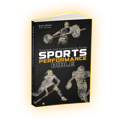How to Write a Strength Program
BUILD YOUR OWN PROGRAM
Download our FREE Template by entering below

How to Write a Strength Program
One of the biggest struggles strength and conditioning coaches have at all levels is figuring out how to write a strength program, especially when looking at it from the top-down perspective. We feel like we are lost in the clouds. We feel like we have no idea where to start. We want to find that endpoint and we have to work backward, feeling in that entire journey to get to that endpoint.
The hard part is that there is non-linear periodization, linear periodization, the complex method, and all of these other high-class words that can be confusing. We just don’t know where to start at times. We don’t have any simple templates. Until now.
In our system, Parabolic Periodization, we have key points established behind programming. Parabolic Periodization for sports performance has a leg day (day 1), an upper-body day (day 2), athlete day (day 3). That is the basic layout. The key talking points will revolve around understanding the leg day, the upper-body day, and the athlete day. Then, inside of each day, we want to understand the role of technical coordination, absolute strength, and accessories play in programming.
Lower Body Strength
On day 1 we dive right in. We want to focus on leg strength through the lower body. The first step we have to take involves understanding the individual’s goals. We also have to understand our goals for the athlete as a coach. We also need to understand the characteristics of the specific sport the athlete is training for. Make sure to follow this pattern to figure out this step-by-step process.

We are going to start with technical coordination. Movement 1a. After the warm-up, we want the athlete to do an exercise that is a technical coordination movement to start things off. A technical coordination movement can be a snatch, a power snatch, a high hang snatch, a two-box clean, a clear, a low hang clean, power clean, or anything along these lines that requires a large amount of coordination. The reason we like to use technical coordination movements to start things off is that the movements are complex and challenging to do. The movements ask for a lot of coordination and involve multiple changes in joint angles.
If we can focus on doing the most challenging movements first, we can potentiate our nervous system to light up and recruit high threshold motor units more effectively. Finally, the transfer of technical coordination movements to other movements is phenomenal. Heavy cleans in particular transfer very well to absolute strength.
So the first exercise, 1a, is focused on technical coordination due to complexity, potentiation, and transfer.
That then brings us to 2a. Exercise 2a focuses on absolute strength. I always use a back squat, a front squat, or a single-leg squat. This is always what I’m doing. Sometimes I pair them with contrast training methods (jumps for exercise 2b) or pairing it with trunk work (dynamic trunk control or specific core work for exercise 2b) as a super-set to either pre-fatigue or post-fatigue setup.
The main reason we put 2a as the absolute strength work is we want to increase brute strength. Brute strength will provide support and foundation work to support technical coordination. It will also help and improve dynamic trunk control which transfers incredibly well to the sports performance world.

That takes us to 3a, which sometimes has a 3b and 3c as well, and is our accessory work. Accessory work can be specific work to improve dynamic trunk control, enhance a glaring weakness in an individual, or do specific, muscle targeting movements. The whole goal is to fill in the gap if there is a glaring weakness, improve dynamic trunk control, and enhance athletic specific patterning.
Upper-Body Day
That takes us to day 2, the upper-body strength day. Again, we have to think about the goals of the athlete and what are the characteristics of the sport being trained for so the athlete can achieve. That is where the pattern comes back in. We have to follow the pattern created to elicit the best responses.
Again, the 1a exercise is a technical coordination movement. For the upper body, we want to focus on behind the neck jerks, push presses, push press behind the neck, power jerks, or split jerks with a pause in the split. Any type of technical coordination movement enhances the transfer and potentiates the nervous system. Remember, it is a complex movement so it should be done first.

2a and 2b with the upper-body work we need to start thinking about improving our absolute strength and relative strength. Absolute strength is the most amount of weight an individual can lift. Relative strength is geared toward pound-for-pound strength. Movements like pull-ups and dips are enhanced by adding load when appropriate to make it more challenging. We really want to focus on absolute and relative strength here.
Typically, 2a will be a bench press super-setted with a curl-up, an incline press super-setted with a rope climb, and/or weighted dips super-setted with neutral grip pull-ups. These are all movements that have been potentiated by the more complex, technical coordination movements from 1a. At 2a and 2b, we are focusing on enhancing absolute and relative strength.
When we are training 3a and 3b (and sometimes 3c), we are focusing on the accessory exercise tree. We want to pull out the specific athlete patterns needed for the sport being trained for. For instance, for someone that is in overhead positions, we want to lengthen their lats and strengthen their shoulders to fill in gaps and enhance athletic, specific patterns. Movements like miracle gros and external shoulder rotations work great. Use the accessory movements to increase specific patterns, enhance what is done in the athlete’s specific sport, and fill in gaps if there are any glaring weaknesses.
Athlete Day
Recognize that we want to increase technical coordination because it transfers so well. It helps with mobility and potentiates the nervous system. We also want to increase absolute strength because it carries over to a lot of other movements and a lot of other sports. In doing so, we also have to remember we are training athletes. We want to enhance sports performance.
Reflexive movements, plyometrics, and speed work transfer really, really well. That is where the athlete day comes into play. The athlete day helps trainees learn how to coordinate as rapidly as possible and be as explosive as possible.
This is where using a specific pattern on athlete day comes into play. We have figured out that the day needs to start off with something easy that enhances stability, improves balance, and potentiates the nervous system. The first key exercise, 1a, almost 99% of the time, is going to be PVC pipe walks. The exercise checks all the boxes.

After executing the PVC pipe walks, that takes us into the plyometric movements we will be using. I like to start off right away with a challenging unilateral plyometric exercise. The movement should be challenging but not the hardest thing. We are starting off with waking the body up from a unilateral aspect, trying to jump with one leg, and landing in as a stable position as possible having decelerated as quickly as possible. Exercise 2a is a unilateral movement focused to wake the body up even more for the rest of the workout.
We want 2a paired with a 2b bilateral movement. Something as simple as a box jump or trap bar jump suffice. The 2b bilateral movement is easier and coincides with the 2a unilateral movement. Now, all the three previous movements lead us into the more complicated part behind athlete day.
We can finish the athlete day off with movements 3a and 3b (or even 4a and 4b with experienced athletes). Typically, for most athletes, 3a and 3b will be the end and the most complicated, challenging movements of the day. 3a needs to be a unilateral movement that asks the athlete to react repeatedly with quick reactions. 3b needs to be a challenging bilateral jump that asks the athlete to change direction, change angle, change speed, and ask the athlete to make calculations of force output.
The important part with athlete day is choosing movements that transfer really well to the athlete’s specific sport. We want to emulate those movements from the specific sport during athlete day.
Recap
We use this basic template for all our athletes. When using the template, know what movements go into the technical coordination movements, what movements increase absolute strength or relative strength, and finally know which movements go into the accessory realm and what issues the accessories are trying to fix. Think of it as a flow chart or exercise tree that fills in the pattern created.
It is important when laying out the program is to know the goals of the athlete, what the coach believes the athlete can accomplish, and pair those together and use that as the key guide to filling in the template. The second step is knowing the key days behind training. Typically I will always say the key days are days one through three. Days four and days five have a bigger focus on mobility and speed work. Days one and two and three are where massive gains can be made. If we understand proper structuring each day, we can lay that out in a proper structure and get the best results from our athletes.
As coaches, we have to implement the exercises and constantly move forward. Coaches, we need to see which exercises work well and the responses that come about over time. It may sound counter, but the form is the key to creativity.
Related Posts
Blog Topics

Yo, It's Dane
Welcome to the Garage Strength Blog, where it is my goal to provide you with the experience and knowledge I've gained in the strength and conditioning world over many years of learning from both successes and failures. I train elite-level athletes in a multitude of sports from the high school to professional levels, already producing 5 Olympics and 30+ National Champions. If you want to be the next champion I train, check out my strength programs below!
Start Training With Me

Join for free educational videos EVERY WEEK on strength coaching and athletic performance



